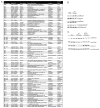Analysis of differentially expressed proteins in Yersinia enterocolitica-infected HeLa cells
- PMID: 26854600
- PMCID: PMC5505629
- DOI: 10.1016/j.bbapap.2016.02.004
Analysis of differentially expressed proteins in Yersinia enterocolitica-infected HeLa cells
Abstract
Yersinia enterocolitica is a facultative intracellular pathogen and a causative agent of yersiniosis, which can be contracted by ingestion of contaminated food. Yersinia secretes virulence factors to subvert critical pathways in the host cell. In this study we utilized shotgun label-free proteomics to study differential protein expression in epithelial cells infected with Y.enterocolitica. We identified a total of 551 proteins, amongst which 42 were downregulated (including Prostaglandin E Synthase 3, POH-1 and Karyopherin alpha) and 22 were upregulated (including Rab1 and RhoA) in infected cells. We validated some of these results by western blot analysis of proteins extracted from Caco-2 and HeLa cells. The proteomic dataset was used to identify host canonical pathways and molecular functions modulated by this infection in the host cells. This study constitutes a proteome of Yersinia-infected cells and can support new discoveries in the area of host-pathogen interactions.
Statement of significance of the study: We describe a proteome of Yersinia enterocolitica-infected HeLa cells, including a description of specific proteins differentially expressed upon infection, molecular functions as well as pathways altered during infection. This proteomic study can lead to a better understanding of Y. enterocolitica pathogenesis in human epithelial cells.
Keywords: Integrin signaling; Label-free proteomics; Pathway modeling; Protein ubiquitination; Yersinia enterocolitica infection.
Copyright © 2016. Published by Elsevier B.V.
Conflict of interest statement
The authors have declared no conflict of interest.
Figures




Similar articles
-
Infected insect gut reveals differentially expressed proteins for cellular redox, metal resistance and secretion system in Yersinia enterocolitica-Helicoverpa armigera pathogenic model.Biotechnol Lett. 2021 Sep;43(9):1845-1867. doi: 10.1007/s10529-021-03157-3. Epub 2021 Jun 24. Biotechnol Lett. 2021. PMID: 34165641
-
Deciphering the acylation pattern of Yersinia enterocolitica lipid A.PLoS Pathog. 2012;8(10):e1002978. doi: 10.1371/journal.ppat.1002978. Epub 2012 Oct 25. PLoS Pathog. 2012. PMID: 23133372 Free PMC article.
-
Interactions between Yersinia enterocolitica and the host with special reference to virulence plasmid encoded adhesion and humoral immunity.Dan Med Bull. 1992 Apr;39(2):155-72. Dan Med Bull. 1992. PMID: 1611921 Review.
-
Destabilization of YopE by the ubiquitin-proteasome pathway fine-tunes Yop delivery into host cells and facilitates systemic spread of Yersinia enterocolitica in host lymphoid tissue.Infect Immun. 2011 Mar;79(3):1166-75. doi: 10.1128/IAI.00694-10. Epub 2010 Dec 13. Infect Immun. 2011. PMID: 21149597 Free PMC article.
-
Experimental Yersinia enterocolitica infection in rodents: a model for human yersiniosis.APMIS. 1993 Jun;101(6):417-29. APMIS. 1993. PMID: 8363822 Review.
Cited by
-
Response of Staphylococcus aureus physiology and Agr quorum sensing to low-shear modeled microgravity.J Bacteriol. 2024 Sep 19;206(9):e0027224. doi: 10.1128/jb.00272-24. Epub 2024 Aug 9. J Bacteriol. 2024. PMID: 39120147 Free PMC article.
-
USP8 inhibition regulates autophagy flux and controls Salmonella infection.Front Cell Infect Microbiol. 2023 Mar 21;13:1070271. doi: 10.3389/fcimb.2023.1070271. eCollection 2023. Front Cell Infect Microbiol. 2023. PMID: 37026055 Free PMC article.
-
PGE2 Augments Inflammasome Activation and M1 Polarization in Macrophages Infected With Salmonella Typhimurium and Yersinia enterocolitica.Front Microbiol. 2018 Oct 31;9:2447. doi: 10.3389/fmicb.2018.02447. eCollection 2018. Front Microbiol. 2018. PMID: 30429830 Free PMC article.
-
Altered quorum sensing and physiology of Staphylococcus aureus during spaceflight detected by multi-omics data analysis.NPJ Microgravity. 2024 Jan 8;10(1):2. doi: 10.1038/s41526-023-00343-7. NPJ Microgravity. 2024. PMID: 38191486 Free PMC article.
References
-
- Van Troys M, Lambrechts A, David V, Demol H, et al. The actin propulsive machinery: the proteome of Listeria monocytogenes tails. Biochem Biophys Res Commun. 2008;375:194–199. - PubMed
-
- Pizarro-Cerda J, Jonquieres R, Gouin E, Vandekerckhove J, et al. Distinct protein patterns associated with Listeria monocytogenes InlA- or InlB-phagosomes. Cellular microbiology. 2002;4:101–115. - PubMed
Publication types
MeSH terms
Grants and funding
LinkOut - more resources
Full Text Sources
Other Literature Sources
Research Materials

